General, Sir John Monash, Personal Files Book 20, 31 July - 15 August - 1918 - Part 1
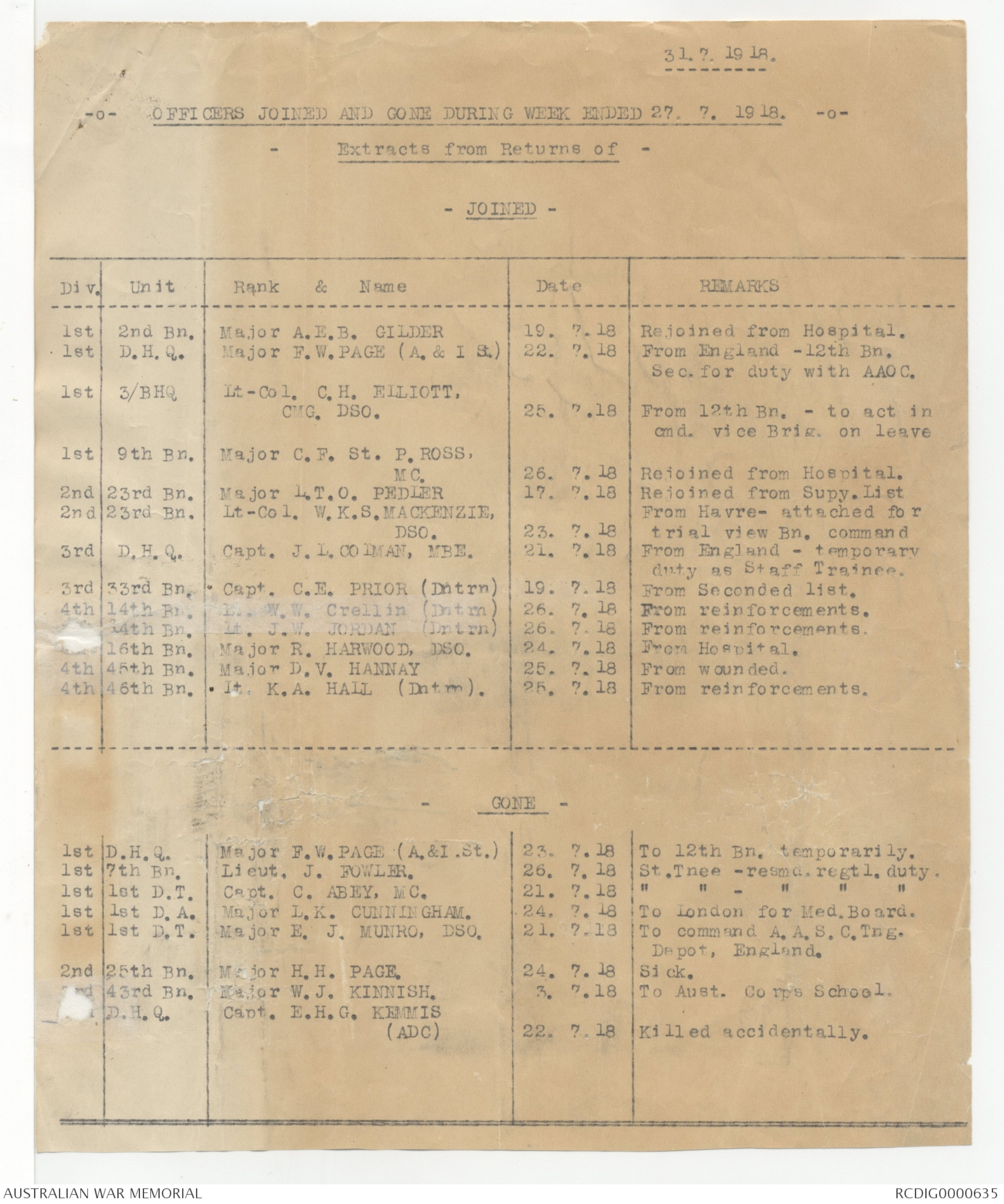
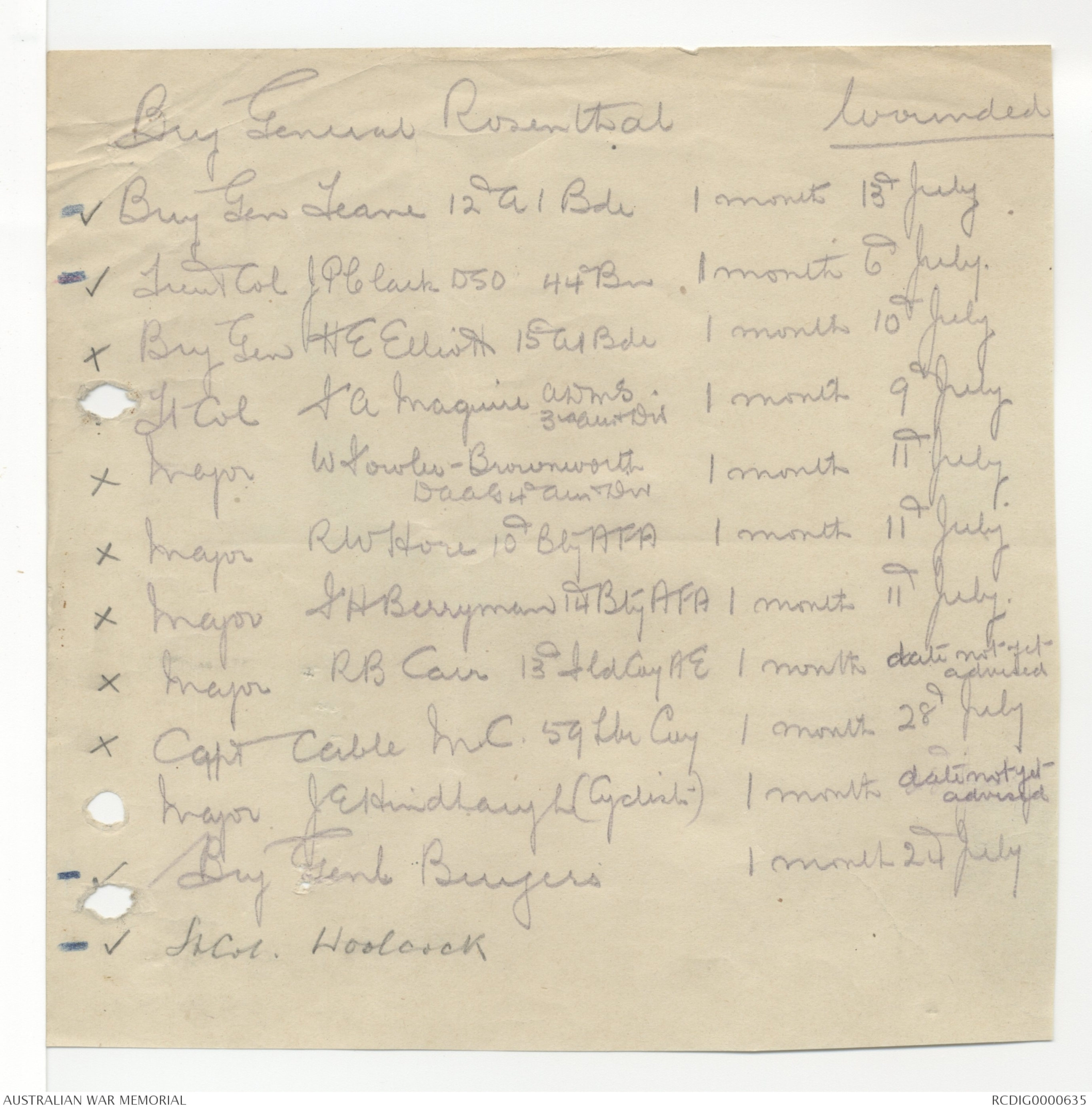
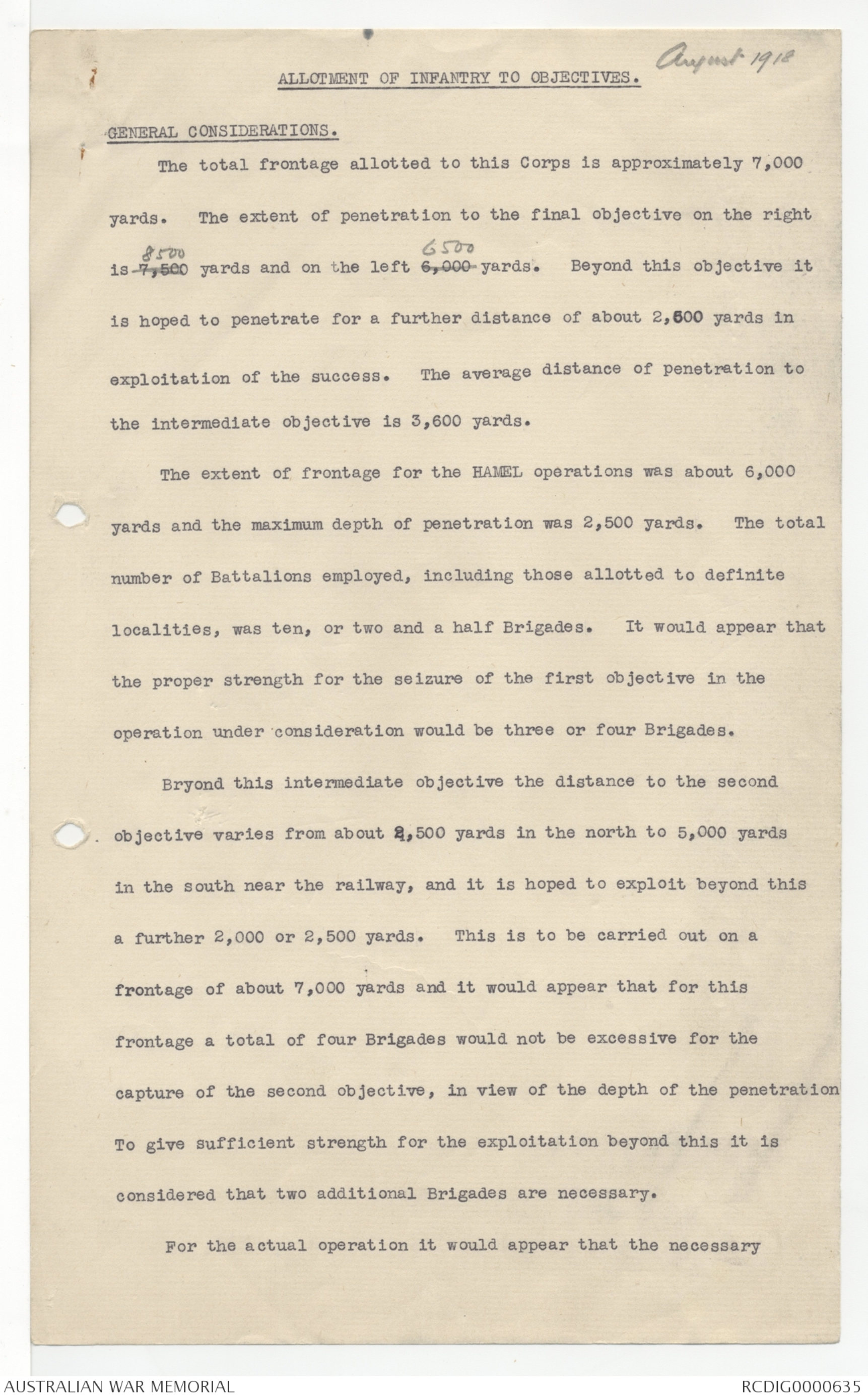
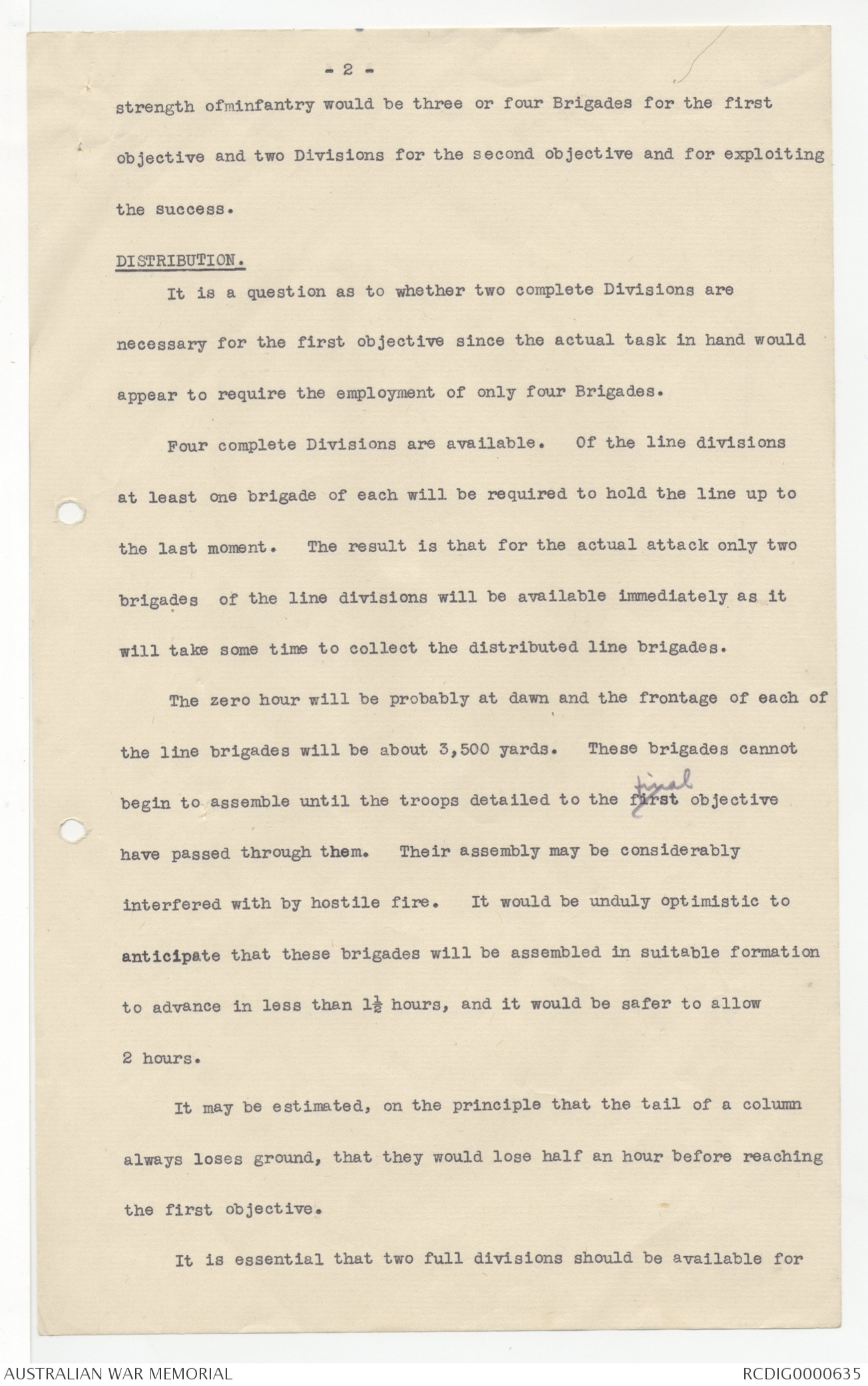
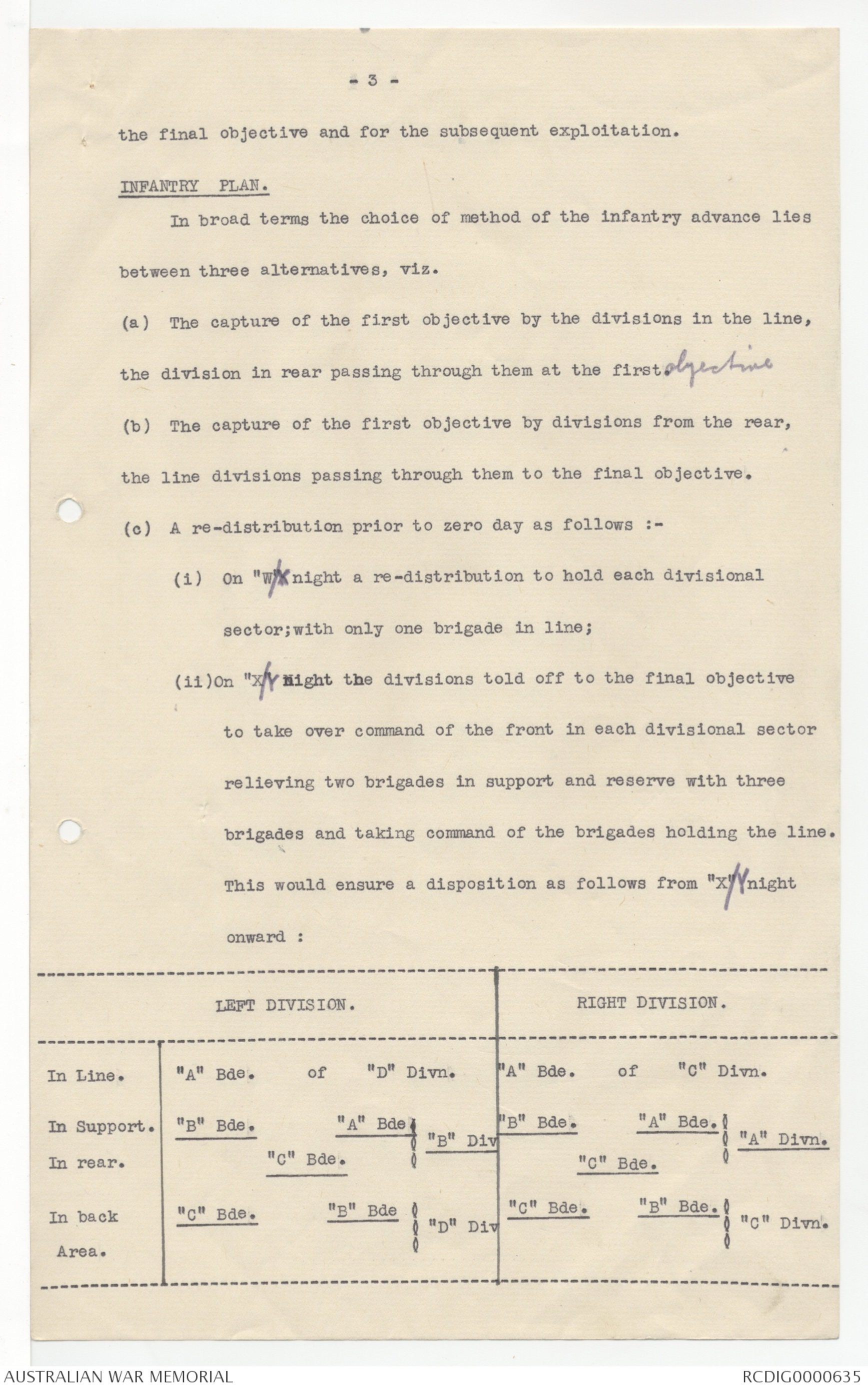
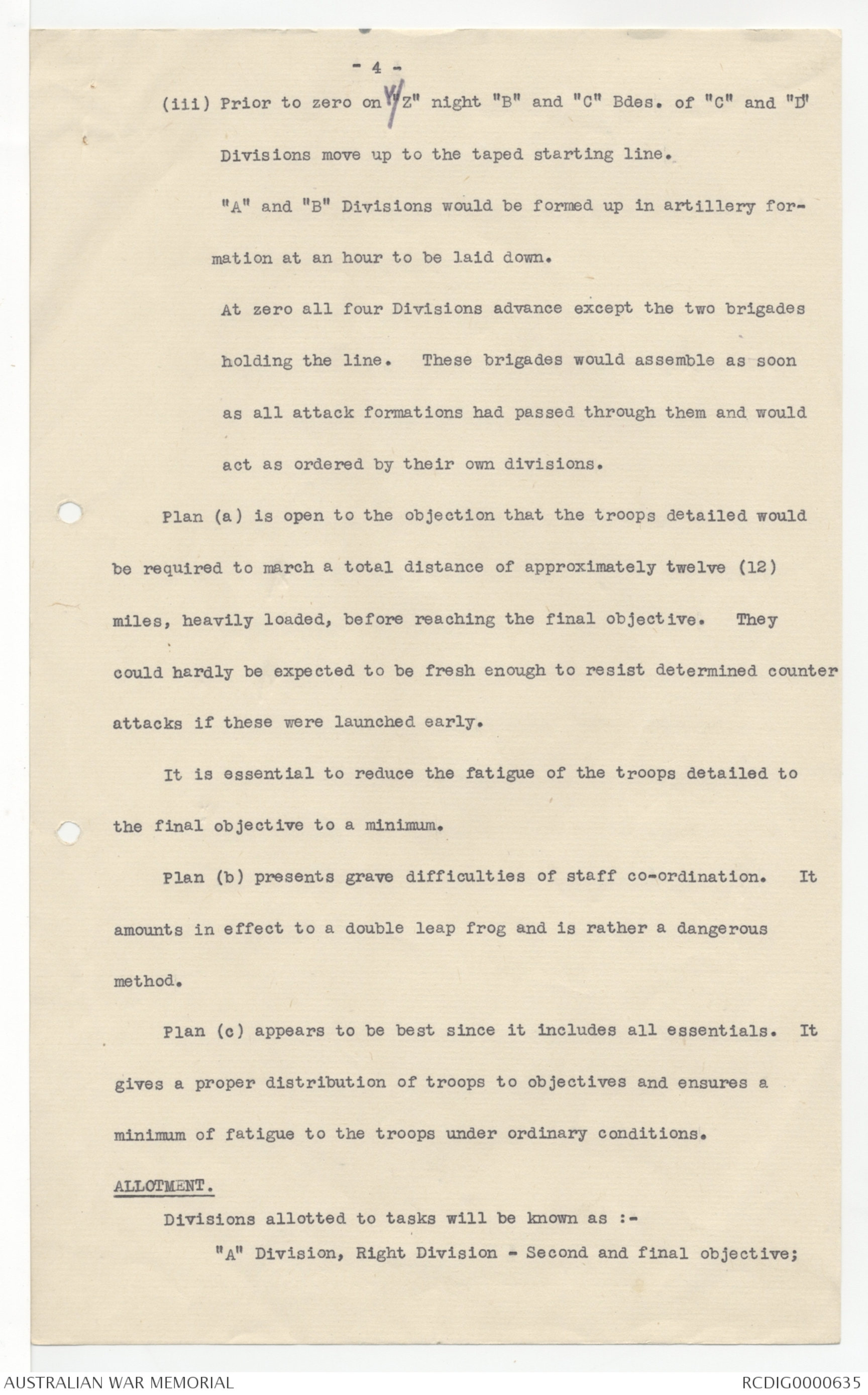
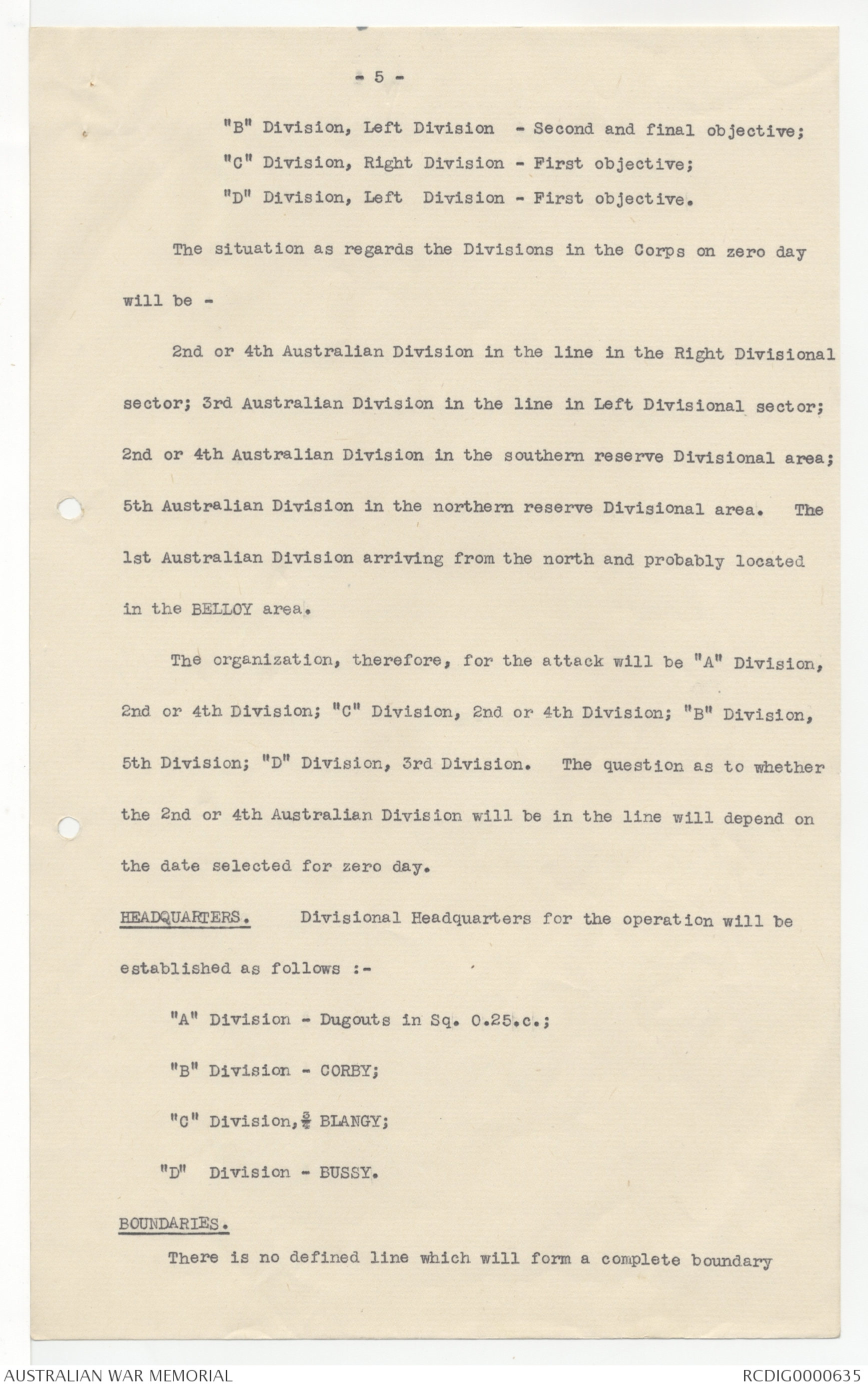
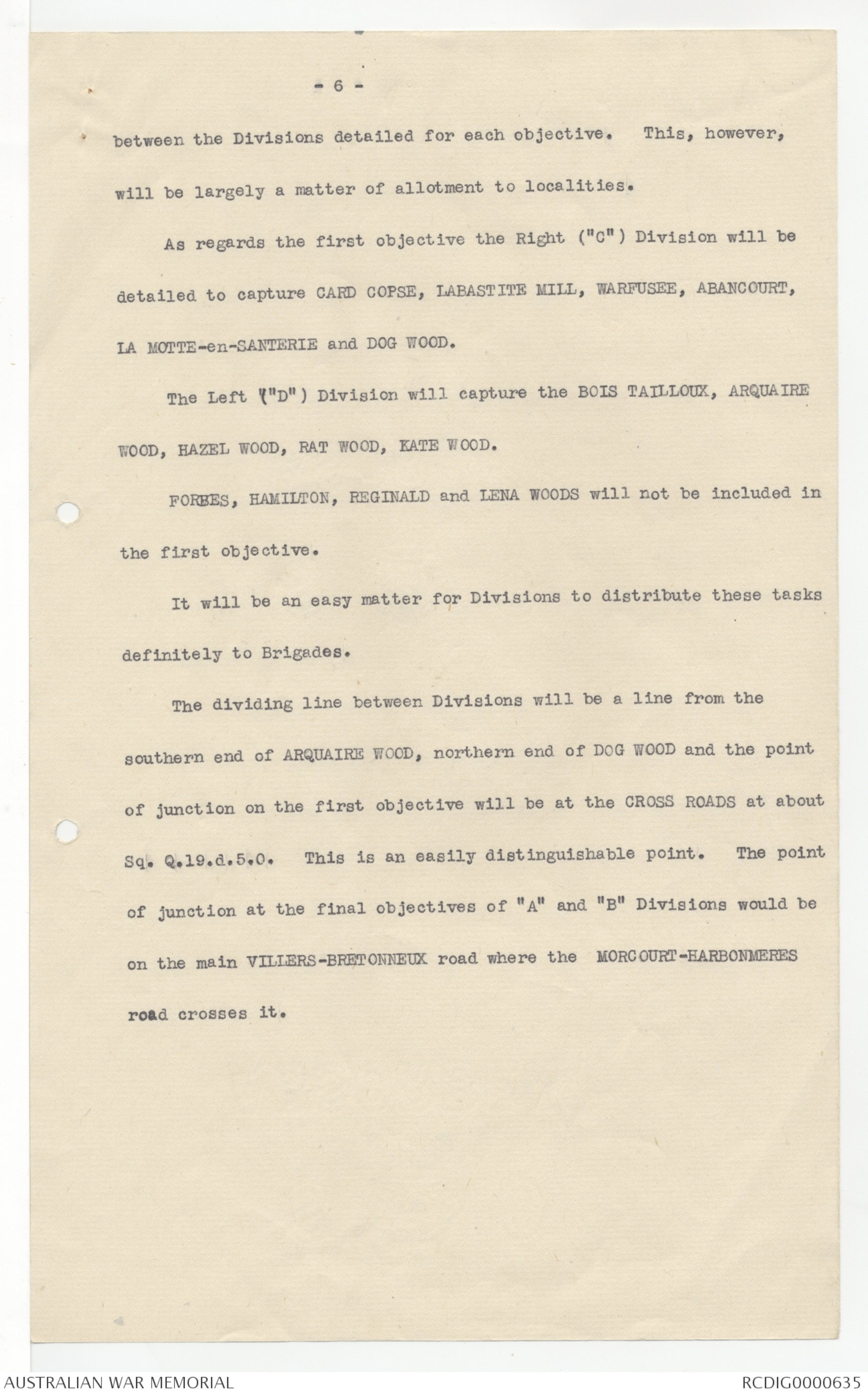
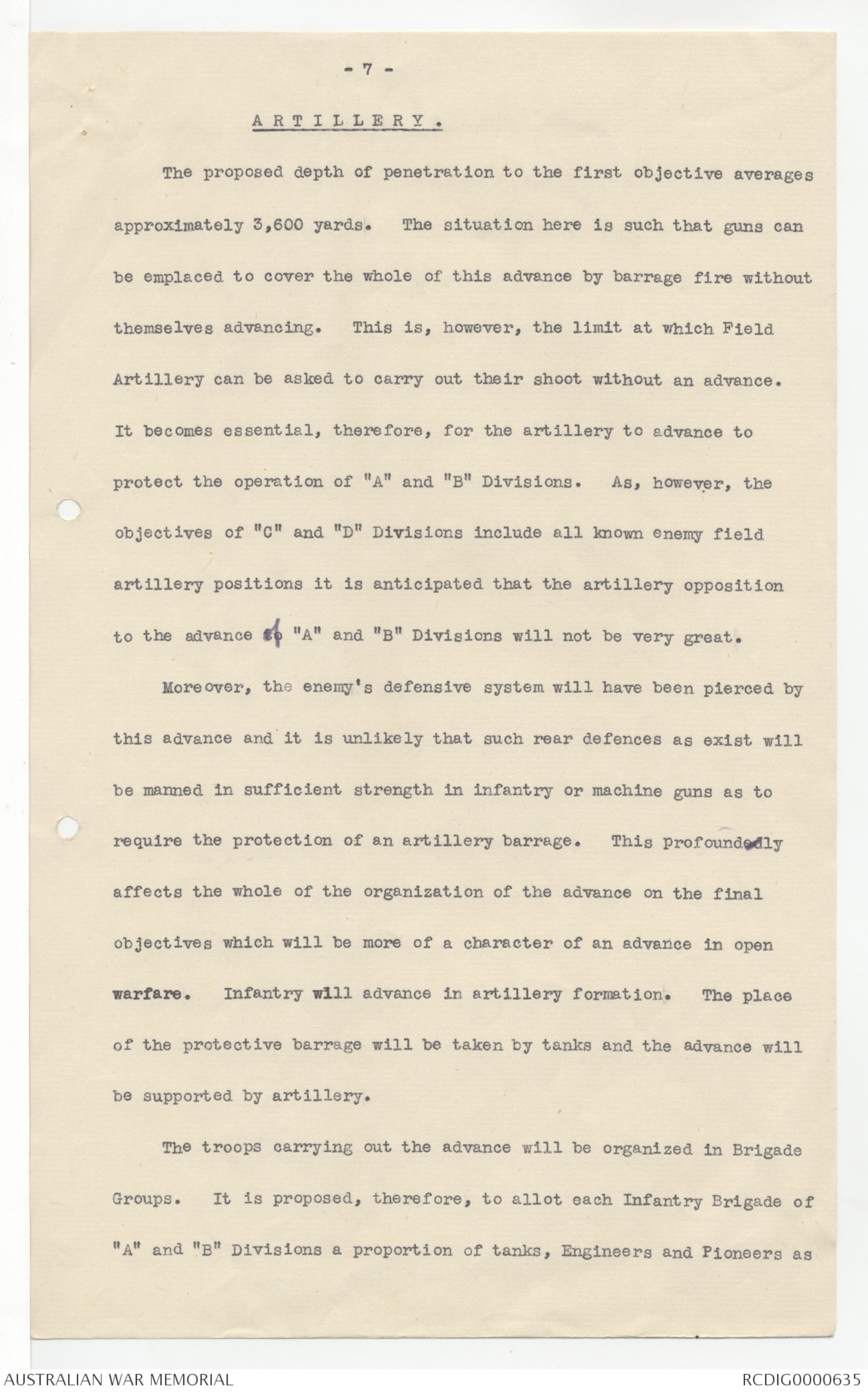
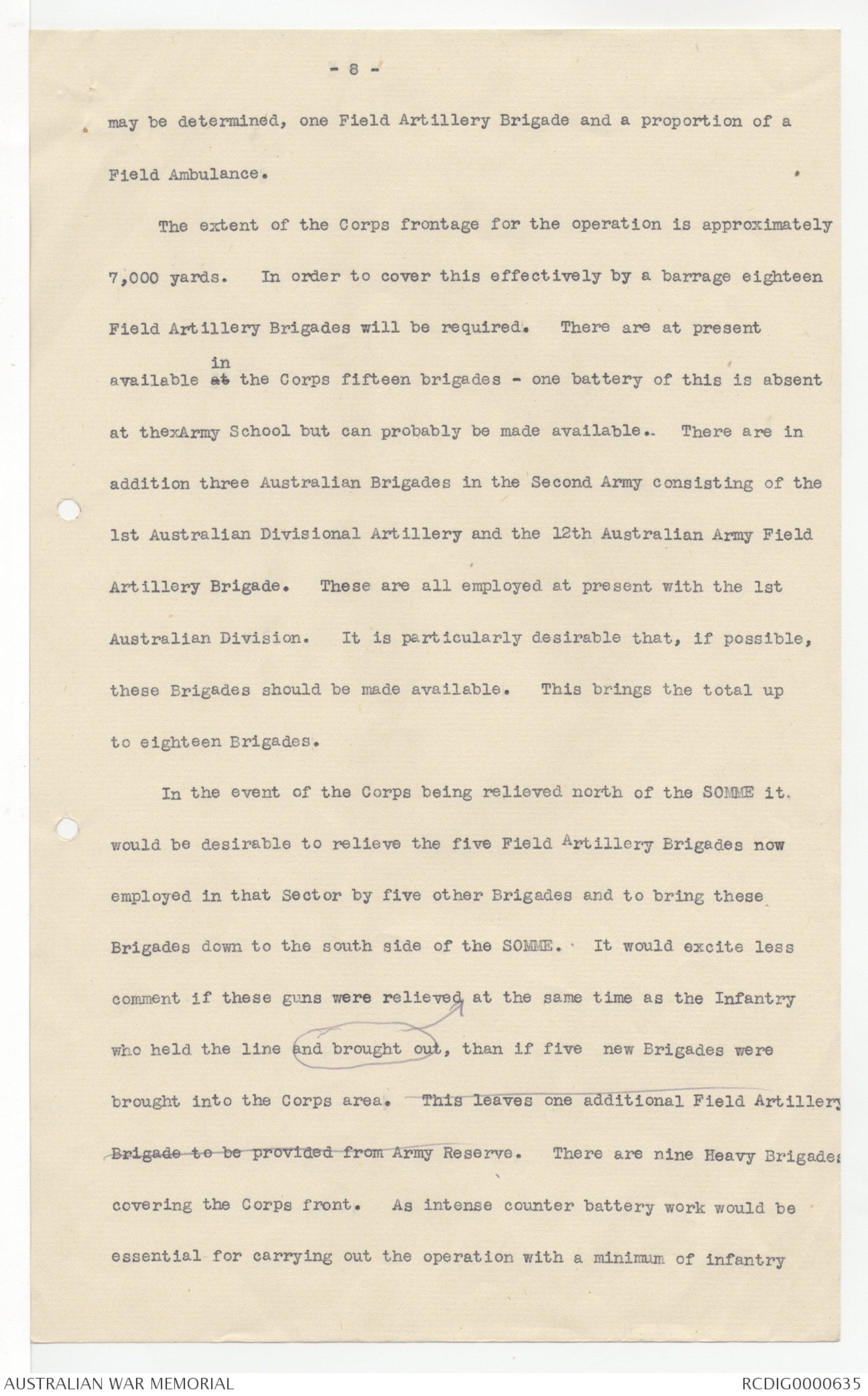
31.7.1918.
OFFICERS JOINED AND GONE DURING WEEK ENDED 27.7.1918
Extracts from Return of -
JOINED
| Div. | Unit | Rank & Name | Date | Remarks |
| 1st | 2nd Bn. | Major A.E.B. GILDER | 19.7.18 | Rejoined from Hospital |
| 1st | D.H.Q. | Major F.W. PAGE (A.& I St.) | 22.7.18 | From England - 12th Bn. Sec. for duty with AAOC. |
| 1st | 3/BHQ |
Lt-Col. C.H.Eillott CMG. DSO. |
25.7.18 | From 12th Bm.- to act in cmd. vice Brig on leave |
| 1st | 9th Bn. |
Major C.F. St. P. ROSS, MC. |
26.7.18 | Rejoined from Hospital |
| 2nd | 23rd Bn. | Major L.T.O. PEDLER | 17.7.18 | Rejoined from Supy. List |
| 2nd | 23rd Bn. | Lt- Col W.K.S. MACKENZIE, DSO. | 23.7.18 |
From Havre- attached for trial view Bn. command |
| 3rd | D.H.Q. | Capt J.L. COIMAN ,MBE. | 21.7.18 |
From England - tempory duty as Staff Trainee. |
| 3rd | 33rd Bn | Capt. C.E. PRIOR (Dntrn) | 19.7.18 | From Seconded list. |
| 4th | 14th Bn | Lt. W.W. Crellin (Dntrn) | 26.7.18 | From reinforcements. |
| 4th | 14th | lt.J.W. JORDAN (Dntrn) | 26.7.18 | From reinforcements. |
| 4th | 16th Bn. | Major R.HARWOOD DSO. | 24.7.18 | From Hospital. |
| 4th | 45th Bn. | Major D.V. HANNAY | 25.7.18 | From wounded. |
| 4th | 46th Bn. | lt. K.A. HALL (Dntrn) | 25.7.18 | From reinforcements |
GONE
| 1st | D.H.Q . | Major F.W. PAGE (A.&I .St.) | 23.7.18 | To 12th Bn. temporarily |
| 1st | 7th Bn. | Lieut. J. FOWLER | 26.7.18 | St. Tnee- resmd.regtl.duty |
| 1st | 1st D.T. | Capt. C. ABEY, MC | 21.7.18 | '' '' - '' '' '' |
| 1st | 1st D.A. | Major L.K. CUNNINGHAM | 24.7.18 | To London for Med. Board |
| 1st | 1st D.T. | Major E.J. MUNRO DSO. | 21.7.18 |
To command A.A.S.C. Tng. Depot, England. |
| 2nd | 25th Bn. | Major H.H. PAGE | 24.7.18 | Sick |
| 3rd | 43rd Bn. | Major W.J. KINNISH | 3.7.18 | To Aust. Coprs School. |
| [[ ]] | D.H.Q. |
Capt E.H.G. KEMMIS (ADC) |
22.7.18 | Killed accidentally. |
Brig General Rosenthal Wounded
| √ | Brig Gen | Leane | 12th A I Bde | 1 month | 13th July |
| √ | Lieut Col | JP Clark | DSO 44thBn | 1 month | 6th July |
| X | Brig Gen | HE Elliott | 15th AI Bde | 1 month | 10th July |
| Lt Col | JA Maguire | ADMS 3rd Aust Div | 1 month | 9th July | |
| X | Major | W Fowler-Brownsworth | DAAL 4th An Div | 1 month | 11th July |
| X | Major | R W Hore | 10th Bty AFA | 1 month | 11th July |
| X | Major | J H Berryman | 14th Bty AFA | 1 month | 11th July |
| X | Major | RB Carr | 13th Fld Coy AE | 1 month | date not yet advised |
| X | Capt | Cable M.C. | 59 Lhr Coy | 1 month | 28th July |
| Major | JE Hindlaigh | (Cyclist) | 1 month | date not yet advised | |
| √ | Brig Genl | Burgess | 1 month | 24th July | |
| √ | Lt Col | Woolcock |
August 1918
ALLOTMENT OF INFANTRY TO OBJECTIVES.
GENERAL CONSIDERATIONS.
The total frontage allotted to this Corps is approximately 7,000
yards. The extent of penetration to the final objective on the right
is 7,500^ 8500 yards and on the left 6,000 6500 yards. Beyond this objective it
is hoped to penetrate for a further distance of about 2,600 yards in
exploitation of the success. The average distance of penetration to
the intermediate objective is 3,600 yards.
The extent of frontage for the HAMEL operations was about 6,000
and the maximum depth of penetration was 2,500 yards. The total
number of Battalions employed, including those allotted to definite
localities, was ten, or two and a half Brigades. It would appear that
the proper strength for the seizure of the first objective in the
operation under consideration would be three or four Brigades.
Beyond this intermediate objective the distance to the second
varies from about 2,500 yards in the north to 5,000 yards
in the south near the railway, and it is hoped to exploit beyond this
a further 2,000 or 2,500 yards. This is to be carried out on a
frontage of about 7,000 yards and it would appear that for this
frontage a total of four Brigades would not be excessive for the
capture of the second objective, in view of the depth of the penetration.
To give sufficient strength for the exploitation beyond this it is
considered that two additional Brigades are necessary.
For the actual operation it would appear that the necessary
-2-
strength ofminfantry would be three or four Brigades for the first
objective and two Divisions for the second objective and for exploiting
the success.
DISTRIBUTION.
It is a question as to whether two complete Divisions are
necessary for the first objective since the actual task in hand would
appear to require the employment of only four Brigades.
Four complete Divisions are available. Of the line divisions
at least one brigade of each will be required to hold the line up to
the last moment. The result is that for the actual attack only two
brigades of the line divisions will be available immediately as it
will take some time to collect the distributed line brigades.
The zero hour will be probably at dawn and the frontage of each of
the line brigades will be about 3,500 yards. These brigades cannot
begin to assemble until the troops detailed to the first final objective
have passed through them. Their assembly may be considerably
interfered with by hostile fire. It would be unduly optimistic to
anticipate that these brigades will be assembled in suitable formation
to advance in less that 1½ hours, and it would be safer to allow
2 hours.
It may be estimated, on the principle that the tail of a column
always loses ground, that they would lose half an hour before reaching
the first objective.
It is essential that two full divisions should be available for
-3-
the final objective and for the subsequent exploitation.INFANTRY PLAN.
In broad terms the choice of method of the infantry advance lies
between three alternatives, viz.
(a) The capture of the first objective by the divisions in the line,
the division in rear passing through them at the first objective.
(b) The capture of the first objective by divisions from the rear,
the line divisions passing through them to the final objective.
(c) A re-distribution prior to zero day as follows :-
(i) On "W/X night a re-distribution to hold each divisional
sector; with only one brigade in line;
(ii) On "X/Y night the divisions told off to the final objective
to take over command of the front in each divisional sector
relieving two brigades in support and reserve with three
brigades and taking command of the brigades holding the line.
This would ensure a disposition as follows from "X/Y night
onward:
| Left Division. | Right Division. | |
| In Line. | ''A'' Bde. of ''D'' Divn. | ''A'' Bde. of ''C'' Divn. |
| In Support | ''B'' Bde. ''A'' Bde. ''B'' Div. | ''B'' Bde. ''A'' Bde. ''A'' Divn. |
| In Rear | ''C'' Bde. | ''C'' Bde. |
|
In back Area |
''C'' Bde. ''B'' Bde. ''D'' Div. | ''C'' Bde. ''B'' Bde ''C'' Div. |
-4-
(iii) Prior to zero on Y/Z" night "B" and "C" Bdes. of "C" and "D"
Divisions move up to the taped starting line.
"A" and "B" Divisions would be formed up in artillery formation
at an hour to be laid down.
At zero all four Divisions advance except the two brigades
holding the line. These brigades would assemble as soon
as all attack formations had passed through them and would
act as ordered by their own divisions.
Plan (a) is open to the objection that the troops detailed would
be required to march a total distance of approximately twelve (12)
miles, heavily loaded, before reaching the final objective. They
could hardly be expected to be fresh enough to resist determined counter
attacks if these were launched early.
It is essential to reduce the fatigue of the troops detailed to
the final objective to a minimum.
Plan (b) presents grave difficulties of staff co-ordination. It
amounts in effect to a double leap frog and is rather a dangerous
method.
Plan (c) appears to be best since it includes all essentials. It
gives a proper distribution of troops to objectives and ensures a
minimum of fatigue to the troops under ordinary conditions.
ALLOTMENT.
Divisions allotted to tasks will be known as :-
"A" Division, Right Division - Second and final objective;
-5-
"B" Division, Left Division - Second and final objective;
"C" Division, Right Division - First objective;
"D" Division, Left Division - First objective.
The situation as regards the Divisions in the Corps on zero day
will be -
2nd or 4th Australian Division in the line in the Right Divisional
sector; 3rd Australian Division in the line in Left Divisional sector;
2nd or 4th Australian Division in the southern reserve Divisional area;
5th Australian Division in the northern reserve Divisional area. The
1st Australian Division arriving from the north and probably located
in the BELLOY area.
The organizations, therefore, for the attack will be "A" Division,
2nd or 4th Division; "C" Division, 2nd or 4th Division; "B" Division,
5th Division; "D" Division, 3rd Division. The question as to whether
the 2nd or 4th Australian Division will be in the line will depend on
the date selected for zero day.
HEADQUARTERS. Divisional Headquarters for the operation will be
established as follows :-
"A" Division - Dugouts in Sq. 0.25.c.;
"B" Division - CORBY;
"C" Division - ¾ BLANGY;
"D" Division - BUSSY.
BOUNDARIES.
There is no defined line which will form a complete boundary
-6-
between the Divisions detailed for each objective. This, however,
will be largely a matter of allotment to localities.
As regards the first objective the Right ("C") Division will be
detailed to capture CARD COPSE, LABASTITE MILL, WARFUSEE, ABANCOURT,
LA MOTTE-en-SANTERIE and DOG WOOD.
The Left ("D") Division will capture the BOIS TAILLOUX, ARQUAIRE
WOOD, HAZEL WOOD, RAT WOOD, KATE WOOD.
FORBES, HAMILTON, REGINALD and LENA WOODS will not be included in
the first objective.
It will be an easy matter for Divisions to distribute these tasks
definitely to Brigades.
The dividing line between Divisions will be a line from the
southern end of ARQUAIRE WOOD, northern end of DOG WOOD and the point
of junction on the first objective will be at the CROSS ROADS at about
Sq. Q.19.d.5.0. This is an easily distinguishable point. The point
of junction at the final objectives of "A" and "B" Divisions would be
on the main VILLERS-BRETONNEUX road where the MORCOURT-HARBONMERES
road crosses it.
-7-
A R T I L L E R Y.
The proposed depth of penetration to the first objective averages
approximately 3,600 yards. The situation here is such that guns can
be emplaced to cover the whole of this advance by barrage fire without
themselves advancing. This is, however, the limit at which Field
Artillery can be asked to carry out their shoot without an advance.
It becomes essential, therefore, for the artillery to advance to
protect the operation of "A" and "B" Divisions. As, however, the
objectives of "C" and "D" Divisions include all known enemy field
artillery positions it is anticipated that the artillery opposition
to the advance of "A" and "B" Divisions will not be very great.
Moreover, the enemy's defensive system will have been pierced by
this advance and it is unlikely that such rear defences as exist will
be manned in sufficient strength in infantry or machine guns as to
require the protection of an artillery barrage. This profoundedly
affects the whole of the organization of the advance on the final
objectives which will be more of a character of an advance in open
warfare. Infantry will advance in artillery formation. The place
of the protective barrage will be taken by tanks and the advance will
be supported by artillery.
The troops carrying out the advance will be organized in Brigade
Groups. It is proposed, therefore, to allot each Infantry Brigade of
"A" and "B" Divisions a proportion of tanks, Engineers and Pioneers as
-8-
may be detarmined, one Field Artillery Brigade and a proportion of a
Field Ambulance.
The extent of the Corps frontage for the operation is approximately
7,000 yards. In order to cover this effectively by a barrage eighteen
Field Artillery Brigades will be required. There are at present
available at^in the Corps fifteen brigades - one battery of this is absent
at thexArmy School but can probably be made available. There are in
addition three Australian Brigades in the Second Army consisting of the
1st Australian Divisional Artillery and the 12th Australian Army Field
Artillery Brigade.These are all employed at present with the 1st
Australian Division. It is particularly desirable that, if possible,
these Brigades should be made available. This brings the total up
to eighteen Brigades.
In the event of the Corps being relieved north of the SOMME it.
would be desirable to relieve the five Field Artillery Brigades now
employed in that Sector by five other Brigades and to bring these
Brigades down to the south side of the SOMME. It would excite less
comment if these guns were relieved ^and brought out, at the same time as the Infantry
who held the line, than if five new Brigades were
brought into the Corps area. This leaves one additional Field Artillery
Brigade to be provided from Army Reserve. There are nine Heavy Brigades
covering the Corps front. As intense counter battery work would be
essential for carrying out the operation with a minimum of infantry
 Sam scott
Sam scottThis transcription item is now locked to you for editing. To release the lock either Save your changes or Cancel.
This lock will be automatically released after 60 minutes of inactivity.